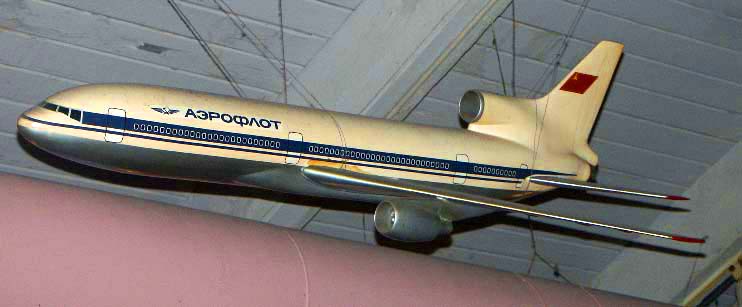Going to need to reread the arms control section a bit more to share my own thoughts on it in detail from what you mentioned.
I significantly enjoyed the bit on aviation, especially for the Soviet Tristar and also how you're going to be seeing the emergence of the Twinstar and DC-10 Twin... and in turn emerging as explicit competitors with the Airbus A310. Y'know, I'm weirdly surprised there wasn't anything talking about the Emergency Loan Guarantee Act and how it ties into how Lockheed is doing.
Glad you're having fun with it! The Carter-era haggling about a possible Lockheed-Soviet deal got close enough to produce tchotchkes for
Aeroflot executives' desks, which is delightful for AH purposes:
There is one graf in there about the Loan Guarantee Act though it's not formally named, beyond that mostly just the backhanded implication that earning some serious rubles would be good for the company books and help get nagging congresscritters *glances sideways at Bill Proxmire* to lay off a little.
As for the great wide-body race that's coming ITTL yes, we get opportunities for Glorious Photoshopped Passenger Aviation Porn like, well, like this:
The DC Twin in the hands of a couple of likely customers
And a really very nicely done image of the -600 from Lockheed done up to look like one of their OTL advertisements for the trijet version
And if McDonnell Douglas can manage to, y'know, have not quite so many
mass-casualty crashes with the big bird in the Seventies, so that it doesn't pick up that "Death Cockpit 10" rep it took years to recover from (and, along with some rather disastrous engine choices for the later models of the MD-80 commuter series, probably killed McDonnell Douglas' civil aviation business) we might get to see the Super Sixty that MD was dead keen to build, which is basically a premature Boeing 777 back when you still needed at least three engines over water (the politics of ETOPS might get interesting by the Eighties, with MD determined to dance with the trijets that brought them and other makers jockeying to get their mid-sized twins with modern, more reliable engines on routes bigger than the Caribbean or the Bay of Bengal.)
But we'll see. Interesting times. If Boeing's "N" and "X" projects turn into something substantively like the 757 and 767, respectively, of OTL, they will be substantively better-performing aircraft than the early wide-bodies jockeying in the
McGoverningverse (of which the Lockheed L-1011-600 and late-model Airbus A300s are the better of the batch, ahead of the rather underpowered DC Twin that holds more bums in seats but can only go about two-thirds as far, if the cargo doors and other bits agree to stay on in flight...) But with earlier deregulation we're likely to see the -600 and Airbus and the DC Twin duking it out among the healthier members of the regulation-era "Big Four" (that'd be American, Eastern, United, and TWA) plus other emerging big players like Delta and Continental, getting in orders before the guys in Seattle can get out of wind-tunnel modeling. We'll see how all that goes. Also what comes of a potential European challenge to the 737/DC-9 end of things, since at this point "Airbus" really is just a consortium of anxious European companies looking for a sweet spot to stay in business by clubbing together. There are several other, variable ways such an organization might have come together, with several other members, on several different projects, not always under the same label. It's a fertile time to be interested in that kind of thing.
And, just to switch gears (ha see what I did there) onto the open road, soon to be a hipster favorite of be-sweatered Western junior academics and foreign-car mechanics, U CANNUT HANDEL TEH MARXIST-LENINIST SEXEH:
Wir machen Spass indeed.


